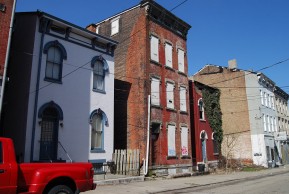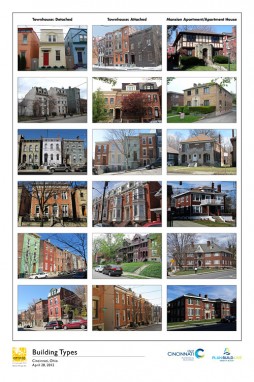
Cincinnati’s urban neighborhoods are at a tipping point. The city has lost 40% of its population since 1950 leaving suburban densities in the city’s formerly urban neighborhoods. Many residential buildings and lots sit vacant or unmaintained, with over 10,000 historically contributing units in need of renovation. Neighborhood main streets have withered due to lack of people, competition from nearby big box stores, and bad thoroughfare design that speeds cars and potential customers through these neighborhoods rather than to them. In addition, jobs followed the people to the suburbs.
But Cincinnati has a tremendous opportunity. In these urban neighborhoods they already have what other cities want and are trying to build: A variety of urban housing types, including some of the best collection of Missing Middle housing in the country; a network of neighborhood main streets ready to be revitalized; and a rich, diverse, and well-built collection of historic architecture; and easily accessible open space networks created by the topography weaving throughout these neighborhoods.

One of the primary reasons for cities like Cincinnati to be optimistic has to do with the convergence of the two biggest population groups, the Millennials (Gen Y, ME generations) and the Baby Boomers, both of which are creating a growing demand for walkable urban places. What the Millennials want and the Baby Boomers need are small, simple spaces for living, a sense of community, people, density, access to transit, and proximity to services and amenities (i.e. main streets and downtowns). The Queen City is positioning itself to capture this demand and putting a strategy in place to make these neighborhoods complete places with everything urban neighborhoods have to offer. A Form-Based Code is one of the tools in their arsenal to achieve these goals. A Sustainable Communities Challenge Grant from the Department of Housing and Urban Design is funding the project.

The week of Saturday April 28, Cincinnati hosted a citywide charrette with a multidisciplinary team that included Opticos Design, Urban Advisors, Brandt Retail Group, Glaserworks, Hall Planning and Engineering, and The Wise Economy Group to frame the city’s challenges and opportunities and to strategize about how a Form-Based Code can be utilized as a tool to enable the city to capture the potential of their unique urban neighborhoods and achieve “Thriving Re-Urbanization,” which is a primary goal of the city’s newly drafted Comprehensive Plan. As part of the charrette process, Opticos built upon months of field documentation, including many hours spent on Google Earth, mapping analysis, photography, and an assessment of the existing zoning code, to create an initial calibration of Cincinnati’s Rural-to-Urban Transect.
Cincinnati is making their move to capture the demand for urban living. Is your city ready?
– Dan
Read part 2 of this series, “Addressing Missing Middle Housing and Missing People in the Queen City: Cincinnati’s Form-Based Code and Transect,” here.
Like this article? How about these: